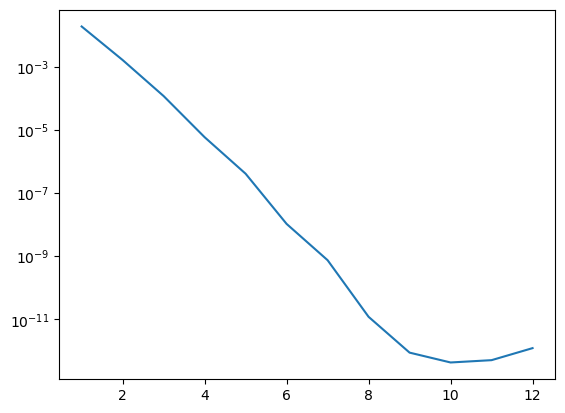This page was generated from unit-9.3-highorder/highorder.ipynb.
9.3 High Order Finite Elements¶
Finite elements implement the basis functions: myHOElement.hpp myHOElement.cpp
Finite element spaces implement the enumeration of degrees of freedom, and creation of elements: myHOFESpace.hpp myHOFESpace.cpp
[1]:
from ngsolve.fem import CompilePythonModule
from pathlib import Path
m = CompilePythonModule(Path('mymodule.cpp'), init_function_name='mymodule')
called mymodule
In file included from /usr/bin/../include/netgen/include/../meshing/meshing.hpp:26,
from /usr/bin/../include/netgen/include/meshing.hpp:1,
from /usr/bin/../include/netgen/nginterface_v2.hpp:419,
from /usr/bin/../include/netgen/meshaccess.hpp:11,
from /usr/bin/../include/netgen/comp.hpp:52,
from /root/src/ngsolve/docs/i-tutorials/unit-9.3-highorder/mymodule.cpp:1:
/usr/bin/../include/netgen/include/../meshing/topology.hpp: In static member function ‘static short int netgen::MeshTopology::GetNEdges(netgen::ELEMENT_TYPE)’:
/usr/bin/../include/netgen/include/../meshing/topology.hpp:374:1: warning: control reaches end of non-void function [-Wreturn-type]
374 | }
| ^
[2]:
from netgen.occ import unit_square
from ngsolve import *
from ngsolve.webgui import Draw
mesh = Mesh(unit_square.GenerateMesh(maxh=0.2, quad_dominated=False))
We can now create an instance of our own finite element space:
[3]:
fes = m.MyHighOrderFESpace(mesh, order=4, dirichlet="left|bottom|top")
and use it within NGSolve such as the builtin finite element spaces:
[4]:
print ("ndof = ", fes.ndof)
ndof = 489
[5]:
gfu = GridFunction(fes)
gfu.Set(x*x*y*y)
Draw (gfu)
Draw (grad(gfu)[0], mesh);
and solve the standard problem:
[6]:
u,v = fes.TnT()
a = BilinearForm(grad(u)*grad(v)*dx).Assemble()
f = LinearForm(10*v*dx).Assemble()
gfu.vec.data = a.mat.Inverse(fes.FreeDofs())*f.vec
Draw (gfu, order=3);
[7]:
errlist = []
for p in range(1,13):
fes = m.MyHighOrderFESpace(mesh, order=p)
func = sin(pi*x)*sin(pi*y)
gfu = GridFunction(fes)
gfu.Set(func)
err = sqrt(Integrate( (func-gfu)**2, mesh, order=5+2*p))
errlist.append((p,err))
print (errlist)
[(1, 0.01847055901538545), (2, 0.0016028677378614217), (3, 0.00011616801306597612), (4, 5.80381522616505e-06), (5, 4.0568753743986986e-07), (6, 1.0483438418049003e-08), (7, 7.453675123934696e-10), (8, 1.2049863405103921e-11), (9, 8.874250841087325e-13), (10, 4.3306659616668924e-13), (11, 5.126904771937532e-13), (12, 1.231766820985857e-12)]
[8]:
import matplotlib.pyplot as plt
n,err = zip(*errlist)
plt.yscale('log')
plt.plot(n,err);

Exercises:
Extend MyHighOrderFESpace by high order quadrilateral elements.
http://www.numa.uni-linz.ac.at/Teaching/PhD/Finished/zaglmayr-diss.pdf, page 68 ff
[ ]: